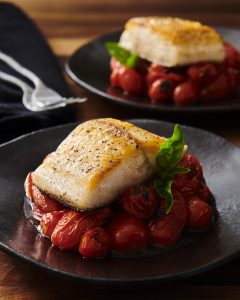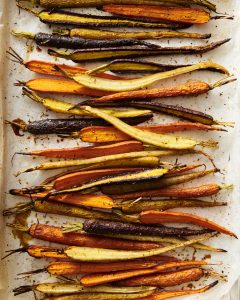Family-Friendly, Brain Healthy!
During the High Holidays, we all have the tendency to overindulge, promising ourselves that tomorrow will be the start of a healthier eating routine. The following dishes from my new book, The Brain Boosting Diet, co-authored with Edward Wein, PhD, are not only family-friendly, they’re also brain-healthy—just what the doctor ordered! They’re perfect for the yamim tovim and are ideal to serve in the sukkah. L’Shanah Tovah U’metukah—wishing you and your family a sweet, healthy, delicious New Year!
Deconstructed Cabbage Rolls
Adapted from The Brain Boosting Diet: Feed Your Memory, by Norene Gilletz and Edward Wein, PhD (Whitecap)
Yields 10 servings
My friend Lela Kornberg used to make stuffed cabbage rolls, but her kids always unrolled the leaves and only ate the meat! This updated version solves that problem. If you use coleslaw mix, it almost disappears in the sauce when cooked. Perfect for fussy eaters.
Vegetables:
2 medium onions, thinly sliced
2 cloves garlic (about 2 teaspoons), minced
1 package (16 oz) coleslaw mix (or 6–8 cups thinly sliced cabbage)
Sauce:
5 cups tomato sauce (preferably low-sodium or no-salt-added)
1/4 cup Splenda Brown Sugar Blend
2 tablespoons lemon juice or white vinegar
3 or 4 bay leaves
Meatballs:
2 lb lean ground turkey (or lean ground beef, chicken or veal)
1 large egg + 2 egg whites (or 2 large eggs)
1/3 cup uncooked quinoa (see Norene’s Notes)
1/4 cup tomato sauce (preferably low-sodium or no-salt-added)
1/2 teaspoon salt (or to taste)
1/4 teaspoon freshly ground black pepper
1 teaspoon dried basil
1 teaspoon garlic powder
1/2 cup rolled oats or matzah meal (gluten-free or whole wheat)
Preheat oven to 350°F. Spray a large casserole with nonstick cooking spray.
Layer half the vegetables in the prepared casserole; reserve the remaining vegetables.
Combine tomato sauce, Splenda and lemon juice in a medium bowl; mix well.
In a large bowl, combine all meatball ingredients and mix lightly. Wet your hands and shape mixture into 40 meatballs, about 1 1/2 inch in diameter, then add to the casserole. Top with the remaining vegetables and bay leaves. Pour sauce over and cover the pan tightly with foil.
Bake for 1 1/2 hours. Uncover and bake 1/2 hour longer to thicken the sauce. Discard bay leaves before serving.
Norene’s Notes:
Leftover Quinoa? Instead of uncooked quinoa, use 1 cup leftover cooked quinoa in the meatball mixture.
Variation: Substitute rice for quinoa in the meatball mixture.
Just the Meatballs: Omit vegetables. Prepare sauce and meatballs and cook as directed above. Kid-friendly!
Slow Cooker Method: Layer ingredients in the sprayed insert of a 6-quart slow cooker. Cook on low for 8 hours.
Low & Slow Brisket
Adapted from The Brain Boosting Diet: Feed Your Memory, by Norene Gilletz and Edward Wein, PhD (Whitecap)
Yields 8 servings
Assemble all the ingredients in your slow cooker, plug it in and walk away! There’s usually no need to add water because the onions and meat juices create lots of gravy. Perfect for Shabbat, the major Jewish holidays or any other special occasion.
3–4 large onions, sliced
1 beef brisket (4 lb) (see Norene’s Notes)
Salt and freshly ground black pepper
to taste
4 teaspoons minced garlic
1/4 cup tomato paste
1/4 cup apricot preserves (reduced-sugar or all-fruit)
2 tablespoons balsamic vinegar, wine
or water
24 baby carrots
Spray a slow cooker insert with nonstick cooking spray. Scatter onions in the bottom of the insert and place brisket on top of the onions.
Season brisket on both sides with salt, pepper and garlic. Smear tomato paste and apricot preserves on both sides and drizzle vinegar over top. Tuck in carrots around the brisket. Cover and refrigerate up to 24 hours.
Cook brisket on low until tender, about 8–10 hours, depending on your slow cooker. (If you put the brisket into the slow cooker just before going to bed, your house will smell amazing in the morning!) Let cool in pan gravy for 1–2 hours.
Transfer brisket to a cutting board and slice across the grain into 1/4-inch slices (an electric knife works well). Return sliced brisket to the slow cooker insert.
Cook, covered, for about 1 hour on low, until fork-tender. (If you plan to serve this the next day, refrigerate overnight, discard congealed fat, then reheat on low for 1–2 hours.)
Norene’s Notes:
Flat or Fat, Double or Single? Beef brisket is divided into 2 sections. The flat cut has less fat and is usually more expensive than a point brisket, which is much fattier as well as more flavorful. A double brisket (second cut) has a thick layer of fat between the two sections. Ask your butcher to trim the meat, leaving a thin layer of fat.
Fat-Saving Tip: Cook brisket a day in advance and refrigerate. Discard congealed fat before slicing and reheating.
Time-Saving Tip: If your brisket is very large (8–10 lbs), cut it crosswise, creating two smaller briskets (4–5 lbs each). Cook, tightly covered in a large roasting pan, for 3–4 hours, until fork-tender.
Overnight Oven Method: No slow cooker? Cook brisket, tightly covered, in a large roasting pan in a 250°F preheated oven for 8 hours or overnight.
Variation: Instead of apricot preserves, use duck sauce or cranberry sauce.
Black Cod With Tiny Roasted Tomatoes
Adapted from The Brain Boosting Diet: Feed Your Memory, by Norene Gilletz and Edward Wein, PhD (Whitecap)
Yields 4 servings
One oven, two pans—this easy and elegant meal is excellent for entertaining. You won’t have to fish for compliments!
Tiny Roasted Tomatoes:
4 cups (about 2 pints) cherry or grape tomatoes
2 cloves garlic (about 1 teaspoon, minced)
Salt and freshly ground black pepper
2 tablespoons olive oil
Fish:
4 black cod fillets (5 oz each)
Salt and freshly ground black pepper
2 cloves garlic (about 1 teaspoon minced)
2 tablespoons chopped fresh basil + extra for garnish
Preheat oven to 400°F. Place an oven rack in the lower third of the oven and a second rack in the middle of the oven.
Line a rimmed baking sheet with parchment paper. Add tomatoes and sprinkle with garlic, salt and pepper. Drizzle with olive oil and, using your hands, mix well, coating tomatoes on all sides. Spread out evenly and roast, uncovered, in the lower third of the oven for 6–8 minutes.
Meanwhile, coat a 9×13 inch glass baking dish with nonstick cooking spray. Place fish in the prepared dish and sprinkle lightly with salt and pepper. Top with garlic and basil.
Place fish on the middle rack of the oven and bake, along with the tomatoes, for an additional 10–12 minutes. When done, fish will flake when gently pressed with a fork and tomatoes will be tender.
Spoon roasted tomatoes over fish and garnish with additional basil. Serve hot or at room temperature.
Norene’s Notes:
Black Cod, also known as sablefish, has a delicate, silky texture and a rich, buttery flavor, which is why it is sometimes called butterfish. It’s delicious poached, baked or grilled, and goes well with Asian flavors.
Halibut with Tiny Roasted Tomatoes: For a different twist, use halibut fillets instead of black cod. Chilean sea bass also makes a scrumptious substitution.
Meal Deal: For a delicious, nutritious dinner, serve with steamed cauliflower or broccoli florets.
Roasted Rainbow Carrots
Adapted from The Brain Boosting Diet: Feed Your Memory, by Norene Gilletz and Edward Wein, PhD (Whitecap)
Yields 6 servings
These multihued roasted carrots are a show-stopper at any meal! Heirloom carrots range in color from orange to yellow to red, and even purple. If you can’t find them, feel free to use the standard orange ones. For maximum flavor, choose fresh bunched carrots.
3 bunches heirloom carrots (about 18)
2 tablespoons olive oil
2 tablespoons honey or maple syrup
2 teaspoons dried thyme or rosemary
Salt and freshly ground black pepper
Preheat oven to 425°F. Line a large, rimmed baking sheet with parchment paper.
Trim tops and ends of carrots, leaving some green. Scrub, rinse well and pat dry with paper towels. Cut carrots lengthwise in halves or quarters, depending on their size.
Spread carrots in a single layer on the prepared baking sheet. Drizzle with olive oil and honey. Sprinkle with thyme, salt and pepper; toss with your hands to coat.
Roast, uncovered, for 40–45 minutes, or until carrots are tender and caramelized, stirring occasionally. Serve hot or at room temperature.
Norene’s Notes:
Garlic-Roasted Carrots: Instead of thyme, add 3–4 teaspoons minced fresh garlic. If desired, add 1 large red onion, halved and sliced.
Sweet and Tangy Carrots: Add a drizzle of balsamic vinegar or lemon juice. Use dill instead of thyme.
Size Counts: Small-to-medium carrots are best. Large carrots have tough, tasteless, woody cores, and are less sweet.
Norene Gilletz, the author of thirteen kosher cookbooks, is also a food writer, food manufacturer, consultant, spokesperson, cooking instructor, lecturer, cookbook editor and podcaster. Norene lives in Montreal, Canada.


